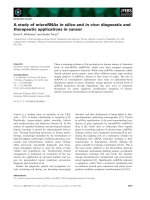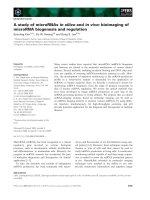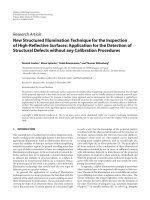Interface study of high k oxide and ge for the future ge based MOSFET device
Bạn đang xem bản rút gọn của tài liệu. Xem và tải ngay bản đầy đủ của tài liệu tại đây (2.29 MB, 109 trang )
Interface study of high-k oxide and Ge for the future
Ge based MOSFET device
DENG WENSHENG
(B.Eng.(Hons.), NTU)
A THESIS SUBMITTED
FOR THE DEGREE OF MASTER OF SCIENCE
DEPARTMENT OF PHYSICS
NATIONAL UNIVERSITY OF SINGAPORE
2011
Acknowledgements
First and foremost, I would like to express my deepest gratitude to my research
advisor, Prof. Feng Yuanping and Dr. Wang Shijie, for their constant guidance and
encouragement throughout years of my study. Their knowledge and passion help me
overcome many difficulties in the journey of research and guide me on the way to
success. I would like to express my warmest thanks to my co-supervisor, Dr. Ng Chee
Mang, without his kindly help and guidance I could not complete my research and
accomplish any goal.
I am extremely grateful to my senior and best friend, Dr. Yang Ming. His invaluable
advice is the key for me to pursuit and finish the master study. It is difficult to
imagine how little I could have done on this thesis without the massive help from Dr.
Yang.
I would like to express my sincere appreciation to GLOBALFOUNDRIES Singapore
for the financial support and to Dr. Chan Lap for both the training he provide and the
valuable advice on my future career. It is a great experience to be taught by Dr. Chan.
I would also like to thank my NUS group members and GLOBALFOUNDRIES SP
group members for their valuable discussions. Special thanks to Dr. Chai Jianwei and
i
Wong Ten It from IMRE for their kindly and selfless help in the experiment.
Last but not the least, my deepest gratitude goes out to my parents. Their inspiration
and encourage bring up my endeavor even in the most difficult moments in this
journey. Their forever love is the most important motivation to push me step forward
in my whole life.
ii
Table of Contents
Acknowledgements ............................................................................................................................ i
Table of Contents ............................................................................................................................ iii
Abstract ............................................................................................................................................. v
List of Tables ...................................................................................................................................vii
List of Figures ............................................................................................................................... viii
Chapter 1
Introduction ....................................................................................................................................... 1
1.1 Si based MOSFET and Scaling Technology ........................................................................... 1
1.2 High-k Dielectrics and Ge Channel in MOSFET.................................................................... 5
1.2.1 Introduction of High-k Dielectrics Materials ................................................................... 5
1.2.2 Introduction of Ge Channel .............................................................................................. 9
1.2.3 Literature Review of Ge with High-k Dielectrics .......................................................... 12
1.3 Motivation, Scope and Thesis Organization ......................................................................... 19
1.4 Reference .............................................................................................................................. 22
Chapter 2
Methodology ................................................................................................................................... 29
2.1 Thin Film Deposition Methods - Sputtering ......................................................................... 31
2.2 Materials Characterization Techniques ................................................................................. 34
2.2.1 Transmission Electron Microscopy ................................................................................ 34
2.2.2 X-ray Diffraction ............................................................................................................ 37
2.2.3 X-ray Photoemission Spectroscopy ............................................................................... 40
2.2.4 Atomic Force Microscopy .............................................................................................. 43
2.3 First-principles Calculations ................................................................................................. 45
2.4 Reference .............................................................................................................................. 49
Chapter 3
Experimental Study of Ge Thin Films Growth on SrTiO3 .............................................................. 51
3.1 Introduction ........................................................................................................................... 51
iii
3.2 Experiment Details ................................................................................................................ 53
3.3 Results and Discussions ........................................................................................................ 55
3.4 Conclusions ........................................................................................................................... 67
3.5 Reference .............................................................................................................................. 68
Chapter 4
First-principles Calculation Study of Interface Properties of SrTiO3 and Ge ................................. 70
4.1 Introduction ........................................................................................................................... 70
4.2 Computational Details........................................................................................................... 72
4.3 Results and Discussions ........................................................................................................ 73
4.3.1 Ge and STO Bulks ......................................................................................................... 73
4.3.2 Endogenous Passivation of Ge Surface.......................................................................... 76
4.3.3 Interfacial Structures and Stability of STO/Ge .............................................................. 79
4.3.4 Electronic Properties at STO/Ge Interface ..................................................................... 82
4.3.5 Electric Field Effects on Interfacial Properties .............................................................. 87
4.4 Conclusions ........................................................................................................................... 89
4.5 References ............................................................................................................................. 90
Chapter 5
Conclusions and Future Works ....................................................................................................... 92
5.1 Conclusions ........................................................................................................................... 92
5.2 Future Works ......................................................................................................................... 95
5.3 Reference .............................................................................................................................. 97
Publications ..................................................................................................................................... 98
iv
Abstract
The progress of continuous scaling of metal-oxide-semiconductor field-effect
transistors (MOSFET) technology is accompanied by many novel materials and
advanced process technologies. High-k dielectrics materials and Germanium (Ge) are
two most promising aspects for the further improvement when the international
technology roadmap for semiconductors (ITRS) hits 22nm and below. High-k
dielectrics gate oxide is critical to replace current SiO2 with thickness limitation of
2nm and alternative high mobility Ge channel can dramatically improve the device
performance.
This thesis examines the interface and surface properties of Ge and high-k materials
SrTiO3 (STO) from both the experiment and first-principles calculation. In the
experiment part, Ge is grown on top of the STO (100) substrate through direct DC
sputtering with atomic oxygen source treatment. From high resolution XRD results, it
can be concluded that 500 °C substrate temperature leads to the single crystalline Ge
(111) thin film while 650 °C substrate temperature changes the thin film to Ge (100).
This single crystalline structure and clean interface are verified by HRTEM images.
STEM EDX line-scan reveals the phenomenon of Ge diffusion at interface, which is
much more serious at higher deposition temperature. The stable surface bonding is
Ge-TiO2 terminated instead of -SrO in the Si and high-k interface. XPS analysis of
the Ge thin films shows the existence of oxidation states at the interface, which is a
v
mix of Ge2O (Ge1+) and GeO (Ge2+) components. The HRTEM and AFM images of
samples with 6mins deposition time present the Nanocrystal (NC) islands for the Ge
and the density is around 3.68×1012cm-2. This highly integrated NCs (~1012 cm−2) is
very useful for the application of floating – gate (FG) in the nonvolatile memory
(NVM) technology.
In the first-principles calculation part, Hybrid-functionals calculations have been
employed to study interfacial electronic properties of perovskite SrTiO 3 (001)/Ge
(100). It is found that the Ge surface states of Ge p-(2×1) can be effectively removed
either by one Sr or two O atoms, and the surface passivated by two oxygen atoms is
more energetically favorable. Interface structure of SrTiO3 with TiO2 terminated
surface is more stable despite the different surface chemical environments of Ge, and
the interface structures without dangling bonds show semiconductor character. It is
also noted that the relative stability of the insulating interface structures is not affected
by the external electric field.
vi
List of Tables
Table 1.1.
Static dielectric constant (K), experimental band gap and (consensus)
8
conduction band offset on Si of the candidate gate dielectrics.
Table 1.2.
Material characteristics of alternative channel materials.
10
Table 4.1.
Structural and electronic properties of bulk Ge.
73
Table 4.2.
Relative interface formation energy of STO on O passivated Ge (100).
82
Table 4.3.
Relative interface formation energy of STO on Sr passivated Ge (100).
82
vii
List of Figures
Figure 1.1.
Schematic of a typical bulk MOSFET structure. Four terminals are denoted as
1
Gate (G), Source (S), Drain (D), and Body (B). Geometry parameters are
denoted as gate length (L) and gate width (w).
Figure 1.2.
Historical trend agrees with the Moore’s Law. Number of transistor in the
2
Intel Micro Processor increases exponentially over time.
Figure 1.3.
Near-term high-performance logic technology requirements in ITRS 2005.
3
Figure 1.4.
A schematic showing a possible combination of technology boosters. In the
4
front end, device has high-k dielectric, metal gate electrode, and thin body,
high mobility InGaAs for n-FET and Ge for p-FET. The back end
interconnect includes low-k dielectric and low resistive metal Cu.
Figure 1.5.
Gate leakage current, JG (SiON-based devices), and equivalent oxide
5
thickness (EOT) of CMOS technologies, vs. the expected production year of
these technologies. When the leakage current flowing through the SiON layer
exceeds the ITRS requirements (here for low stand-by power technologies),
an alternative gate dielectric should be used.
Figure 1.6.
(a) the drain to source current (Id) plotted against the drain to source voltage
15
(Vd) as a function of different gate voltages (Vg) in the GeOI-MOSFET; (b)
high
resolution
transmission
electron
micrograph
of
an
epitaxial
Si(111)/LaYO/Ge structure.
Figure 1.7.
Overview of important epitaxy parameters to achieve the integration of high
16
quality semiconductor layers via oxide heterostructures on Si.
Figure 2.1.
Schematic sputtering systems (a) DC and (b) RF.
33
Figure 2.2.
The magnetic field configuration for a circular planar magnetron cathode.
33
Figure 2.3.
Schematic of TEM (left) and STEM (right).
35
Figure 2.4.
Bragg's Law reflection. The diffracted X-rays exhibit constructive
37
viii
interference when the distance between paths ABC and A'B'C' differs by an
integer number of wavelengths (λ).
Figure 2.5.
Schematic of a Powder X-ray diffracto=meters.
38
Figure 2.6.
Electronic processes in X-ray photoelectron spectroscopy.
41
Figure 2.7.
Overview of the VG ESCALAB 220i-XL XPS system.
42
Figure 2.8.
Schematic diagram of a scanned-sample AFM.
44
Figure 3.1.
XRD θ-2θ scan of Ge films deposited on STO (100) at temperatures of (a)
56
500 °C and (b) 650 °C, respectively. The insets show the ω peaks of (b) Ge
(111) and Ge (400) peaks, respectively.
Figure 3.2.
XRD phi (Φ) scans of Ge (111) plane and STO (111) plane for Ge sputtered
57
on STO (100) at 500 °C.
Figure 3.3.
Cross section HRTEM images of the Ge films deposited on STO (100): (a)
59
the formation of crystalline Ge (111) on STO (100) at the substrate
temperature of 500°C, (b) a schematic interfacial atomic structure for Ge
(111)/STO (100), (c) the formation of crystalline Ge (001) on STO (100) at
the substrate temperature of 650°C, and (d) a schematic interfacial atomic
structure for Ge (001)/STO (100).
Figure 3.4.
STEM EDX line-scan of interfacial chemical compositions for the Ge films
61
on STO (100) at temperature of: (a) 500 °C and (b) 650 °C. The vertical line
indicates the position of the Ge/STO interface.
Figure 3.5.
The XPS core-level spectra of Ge 3d for the Ge thin films grown on STO
62
(100) with the deposition time of 6 mins at the temperature of (a) 500 °C and
(b) 650 °C.
Figure 3.6.
Cross section HRTEM images of the Ge films deposited on STO (100) at the
64
substrate temperature of 650°C for 6 mins: (a) 2nm scale, (b) 10nm scale.
Figure 3.7.
AFM images of the Ge films deposited on STO (100) at the substrate
66
temperature of 500°C for: (a) 60mins, (b) 6mins.
Figure 4.1.
(a) Total DOS of STO with/without tensile strain. (b) Projected Ti 3d DOS of
75
STO with and without strain.
ix
Figure 4.2.
Total DOS of Ge surface passvitated by a Sr atom (a), a O atom (b), two O
77
atoms (c), and two Sr atoms (d) (the insets are the corresponding atomic
structures).
Figure 4.3.
Interface structures for STO on Ge passivated by two O atoms.
80
Figure 4.4.
Interface structures for STO on Ge passivated by a Sr atom.
80
Figure 4.5.
The total and projected DOS for the interface structure 3-c.
84
Figure 4.6.
The total and projected DOS for the interface structure 4-a.
85
Figure 4.7.
The rigid shift of O 1s and Ge 3d (inset) DOS between interface structure 3-c
86
and the related bulk.
Figure 4.8.
The rigid shift of O 1s and Ge 3d (inset) DOS between interface structure 4-a
86
and the related bulk.
Figure 4.9.
The dependence of interface stability on the external electric field: (a)
88
interface structure 3-c and (b) interface structure 4-a.
x
Chapter 1
Introduction
1.1 Si based MOSFET and Scaling Technology
We have stepped into the “silicon age” for more than 60 years since the first
semiconductor transistor was invented in December 1947 by John Bardeen and Walter
Brattain at Bell Labs. [1] After the birth of the first generation metal oxide
semiconductor field effect transistor (MOSFET) in 1960, [2] the integrated circuits
(IC, also known as microchips or microcircuits), where MOSFET plays an important
role for the core electronic devices, have been successfully revolutionizing the world
for the past half century. (See Fig. 1.1 for a typical MOSFET)
Figure 1.1. Schematic of a typical bulk MOSFET structure. Four terminals
are denoted as Gate (G), Source (S), Drain (D), and Body (B). Geometry
parameters are denoted as gate length (L) and gate width (w).
1
In order to continuously improve the speed and the functionality of the IC, scaling of
MOSFET technology is a must trend for increasing both the package density and
performance. This scaling behavior as the IC driving force has been vividly described
and predicted by Gordon Moore at 1960: the size of the transistor will be reduced by
two times and the density of devices in a chip will be double for every 18 months (Fig.
1.2). [3, 4] The Semiconductor Industry Association (SIA) has also been publishing
the international technology roadmap for semiconductors (ITRS) since 1992 to reveal
the semiconductor industry’s future technology trends and requirements (Fig. 1.3). [6]
Figure 1.2. Historical trend agrees with the Moore’s Law. Number of
transistor in the Intel Micro Processor increases exponentially over time.
[5]
2
Figure 1.3. Near-term high-performance logic technology requirements in
ITRS 2005. [6]
The enhancement of various electrical parameters of MOSFET (such as gate length,
gate width, gate thickness and power supply voltage) is the key concept for the
MOSFET scaling according to the roadmap and already proposed by Dennard in 1974.
[7] In Fig. 1.1, it is a typical four-terminal bulk MOSFET and the saturated drain
current is given by Equation 1.1, where C is the inversion capacitance, (V g-Vth) is the
gate overdrive, µeff is the effective carrier mobility.
(1.1)
According to Eq. (1.1), in order to achieve a higher drive current (Idsat), we can either
increase gate overdrive power (Vg - Vth), effective carrier mobility (µeff), width (w),
inversion capacitance (C) or reduce channel length (L). The increase of width is
3
contrary with the scaling rule and the increase of power has the reliability concerns.
Besides them, the decrease of gate length can cause short channel effect and currently
the gate length has already reached its fundamental limit. [8] The only parameters left
behind are the effective carrier mobility (µeff) which is the channel carrier mobility
and inversion capacitance(C) which is related to the gate dielectric. Many novel
device technologies and new materials have been proposed to solve the ultimate
scaling issues for future MOSFET by improving these two parameters, e.g. high
mobility channel materials and high-k dielectric. These approaches which are also
named performance boosters by ITRS can control the short channel effect (SCE)
while maintain continuous performance enhancement (Fig. 1.4). [9]
Figure 1.4. A schematic showing a possible combination of technology
boosters. In the front end, device has high-k dielectric, metal gate
electrode, and thin body, high mobility InGaAs for n -FET and Ge for
p-FET. The back end interconnect includes low -k dielectric and low
resistive metal Cu. [9]
4
1.2 High-k Dielectrics and Ge Channel in MOSFET
1.2.1 Introduction of High-k Dielectrics Materials
As mentioned in section 1.1, one major approach to enhance MOSFET performance is
to increase the inversion capacitance(C). Currently in the industry the major material
used for gate dielectric are SiO2 (dielectric constant is 3.9) and SiON (for high
performance technologies, dielectric constant is around 7). In order to meet the
scaling requirement, the thickness of the gate dielectric continues to scale down till
1.5nm. [10, 11] Although this gate dielectric oxide thickness scaling can keep
improving the device performance, it will reach the limit of around 2nm, below which
the gate leakage current density Jg could become unacceptably high (see Fig. 1.5).
Accordingly, it will also increase the static power and degrade device performance.
[12, 13]
Figure 1.5. Gate leakage current, JG (SiON-based devices), and equivalent
oxide thickness (EOT) of CMOS technologies, vs. the expected production
year of these technologies. When the leakage current flowing through the
SiON layer exceeds the ITRS requirements (here for low stand -by power
technologies), an alternative gate dielectric should be used.
5
By introducing high-k gate dielectrics to replace the traditional SiO2 or SiON, the
physical thickness of the high-k gate dielectric can be much thicker compared to the
physical thickness of the SiO2 dielectric with the same equivalent oxide thickness
(EOT can be described at equation 1.2 below).
(1.2)
where tx is the physical thickness of the alternative oxide film and kx is its dielectric
constant, e.g. an oxide film with a dielectric constant of 7.8 can be approximately
twice as thick as a SiO2 film, while still having the same capacitance per unit area to
maintain gate control over a MOSFET. [12] Therefore, the leakage current will be
much smaller even for the EOT less than 1nm. That's to say, high-k materials as the
gate oxide can enable the possibility of device scaling.
Some requirements for selecting the high-k materials for Si-MOSFET are summarized
by M.Houssa: [13]
1. The relative dielectric constant of the high-k material should be somewhere
between 10 and 30, which will give rise to fringe fields from the gate to the
drain or source and these fields can degrade short channel performances.
6
2. The dielectric material must be an insulator with a band gap larger than 5 eV
and the band offsets with silicon must be sufficient. Generally, increasing
dielectric constant leads to lower conduction and valence band offset for
materials in contact with silicon, and there is an inverse relationship between
dielectric constant and the band gap [14]. To prevent conduction by Schottky
emission of electrons or holes into their respective bands, i.e. reduce leakage
current, the barrier at each band must be greater than 1 eV. As a comparison,
the band gap of SiO2 is 9 eV, and the conduction and valence band offsets with
Si are 3.1 eV and 4.8 eV, respectively.
3. Interface preparation and quality are important for layer growth.
4. Low interface trap defect density, Dit, is typically less than 1011 cm-1 eV-1.
5. Thermodynamic stability is essential for direct contact with Si. The oxides
must have a large Gibbs free energy of formation to prevent reaction with Si.
Oxygen diffusion coefficients must be low as they will cause uncontrolled
interfacial layer (re)growth.
7
Table 1.1. Static dielectric constant (K), experimental band gap and (consensus)
conduction band offset on Si of the candidate gate dielectrics.
Table 1.1 shows the properties of a wide variety of high-k materials. These years,
most of them have been studied and indentified as promising gate dielectrics
candidates. In the semiconductor industry, Intel has been already using Hf-based
high-k dielectrics (HfO2 or nitride HfSiOx) for its 45nm technology. Among these
high-k materials in the list, SrTiO3 has the highest dielectric constant ~2000; while
this materials is rarely studied as a candidate for gate dielectrics in Si-MOSFET, due
to its small band gap(~3.2 eV) and small conduction band offset(~0 eV) which could
cause large leakage current. In our study, Ge with smaller band gap (~0.6 eV) is
adopted instead of Si. [16] Taking the advantage of high dielectric constant and small
lattice mismatch to Ge, we will focus on SrTiO3 in this thesis from first-principles
calculation and experimental respects.
8
1.2.2 Introduction of Ge Channel
One of the most important performance boosters is using the transport enhanced
channel to replace the traditional Si based channel in the MOSFET. As stated in
section 1.1, another parameter to increase the saturation current (Ion) with the device
scaling is effective carrier mobility (µeff). The saturation current (Ion) can be
represented by equation 1.3:
(1.3)
where q is the elemental charge, Nsources is the surface carrier concentration near the
source edge, and vs is the carrier velocity near the source edge which is proportional
to the mobility [17, 18]. Especially for the channel length less than 10nm, the carrier
transport is dominated by full ballistic transport. The transistor speed is no longer
determined by saturation velocity but by source injection velocity. Therefore, there is
a must to replace the conventional silicon channel with novel materials with high
mobility for the future generation nanoelectronics.
The characteristics of potential alternative channel materials like Ge, main III-V
semiconductors (GaAs, InSb and InP) are listed in Table 1.2. Among these materials,
it is noted that Ge is the only material that offers high mobility enhancement for both
hole and electron with appropriate bandgap. In addition, its low melting point ensures
9
that the dopant activation temperature is as low as 400°C-500°C. [19, 20]
Table 1.2. Material characteristics of alternative channel materials [16]
Although III-V semiconductors have higher electron mobility, Ge can provide the
highest hole mobility among the main semiconductors, and it has already been
demonstrated that compressively strained Ge p-MOSFETs provide ten times or higher
hole mobility against Si p-MOSFETs. [21-24] The compatibility of Ge with both
nMOSFET [25] and pMOSFET [26] has also been proven. It’s even reported that hole
mobility enhancement of as high as ten is obtained by combing both Ge channel (GOI
with 93% Ge content) and compressive strain, [26] which can further indicate that Ge
is one of the most important future channel materials.
Although Ge is a promising material to be the channel in the MOSFET, there are still
10
many issues yet to be solved: [26]
(1) Gate-insulator formation with high-quality MIS interfaces, the poor properties of
germanium oxides and lack of good quality gate dielectric greatly hinder the
development of Ge MOS device. For example, it is reported that the high density of
interface traps of the gate stacks is one of the possible reasons for the low mobility of
Ge nMOSFET [27];
(2) High-quality Ge or GOI channel layer formation; [28 - 32]
(3) Formation of low-resistivity S/D junctions;
(4) Improvement of poor performance of n-channel MOSFETs;
(5) Reduction in large leakage current;
(6) Appropriate CMOS structures and integration technologies.
In this thesis, we will focus on the point (1) and (2) to discuss about first-principles
study of interface of high-k material (STO) with Ge, and experimental study of crystal
growth of Ge on high-k material (STO) for future application of GOI channel
formation.
11
1.2.3 Literature Review of Ge with High-k Dielectrics
By successfully implementing Ge as MOSFET channel materials integrated with
high-k dielectrics materials, state of the art researches mainly focus on two fields: (1)
Ge on top of the high-k dielectrics material, which constitutes the structure called
Germanium-on-insulator (GeOI); (2) high-k material on top of the Ge, which forms
the stack of high-k gate oxide and Ge active channel.
The first important application of high-k dielectrics in the Ge channel based MOSFET
is the GeOI, which combines high mobility of charge carriers with the advantages of
an Silicon-on-insulator (SOI) structure. It is also an attractive integration platform for
the future IC technology. As the replacement for the SOI structure, a truly realization
of MOSFET on a fully epitaxial structure GeOI channel must involve two material
problems: a uniform epitaxial oxide is needed, and a uniform epitaxial semiconductor
must be grown. [33]
Traditionally, amorphous SiO2 is used as electrical isolation layer; while for the GeOI,
this isolation layer can be any suitable oxide like SiO2 or high-k materials with proper
lattice constant which serves not only the electrical isolation function but also the
buffer layer between Ge cannel and Si substrate.
Large dimension of Ge layers has been directly deposited on Si by using low growth
12
temperature 300–340 °C early at 1994. [34, 35] Due to the large lattice mismatch
between Si and Ge (4.2%), the three-dimensional island nucleation is inhibited, [36 39] which is good to get a flat Ge layer. However, this large lattice mismatch could
also induce high threading dislocation density. The post annealing at 750–890 °C is
necessary and effective to repair this defect but could cause another problem that Si
diffuses from substrate into the Ge film and reduce the purity of Ge epilayer. [40 - 43]
Many reports also represent other methods to grow Ge channel on Si substrate, e.g.
selective growth on patterned Si substrate [44-47] and growth on compositionally
graded SiGe buffers. [48, 49] Although these approaches can provide relatively large
area Ge epilayer, all of them suffer from the same problem: direct contact of Ge and
Si can easily induce Si impurities at Ge epilayer. [50] Also, several micrometers SiGe
buffer layer located in the interface of Ge and Si also put up a question for industry to
integrate Ge into Si-based device. [51]
All these difficulties can be overcome in the GeOI fabrications. The most common
methods for the GeOI fabrication are Ge condensation technique [52] and smart cut
technique (or layer transfer technique). [53] Ge condensation technique or
oxidation-induced Ge condensation is based on oxidation of SiGe epitaxially grown
on the SOI substrate. This method can be useful for the local and thin GeOI formation.
The Ge epilayer thickness is controlled by the Ge fraction and the SiGe layer
thickness. The major drawback is the high thermal budget (>1000°C) and the
oxidation induced plastic deformation. Smart cut technique nowadays is the most
13
widely used approach for GeOI fabrication. Usually for thick Ge film formation, bond
and grinding method is used [54]; for thin Ge film growth, grind and etch-back
method is applied where compositionally graded SixGey is the chosen buffer layer
[55]. Only one of these two methods can be used for one single wafer which is not
applicable for the wafer level GeOI fabrication. Smart cut technology can be efficient
to get both benefits. The basic process flow includes oxide formation, ion
implantation, hydrophilic bonding to a Si base substrate, followed by Ge film transfer
and finishing steps. Wafer diameters from 100 to 200mm with the thickness range
from 200 down to below 50 nm were demonstrated [56 - 58]. However, this method
requires complex processing and has difficulty in obtaining very high-quality Ge
crystals.
In recent years, single crystalline high-k dielectrics have been studied as potential
epitaxial templates for Ge epitaxy. The first report about Epitaxial silicon and
germanium on buried insulator heterostructures with single crystalline oxide dielectric
buffer layer was published by N. A. Bojarczuk et al. in 2003. [33] By using the solid
phase
epitaxy,
the
structure
of
Si(111)/substrate/LaYO/Si
and
Si(111)/substrate/LaYO/Ge (see Fig 1.6(a)) has been grown. It’s noted that the
thickness of the Ge is 4nm and the solid phase epitaxial transformation temperature
for Ge is 450 °C, which is lower than that for Si (around 580°C). Based on this
heterostructure, Ge channel MOSFET is also fabricated and the output characteristics
in Fig 1.6(b) demonstrate a field effect charge inversion in the epitaxial germanium
14









